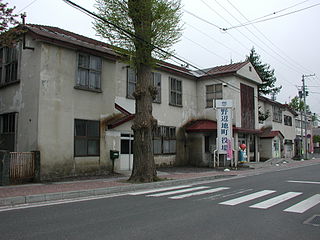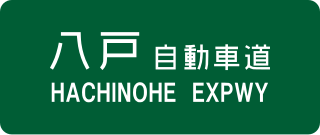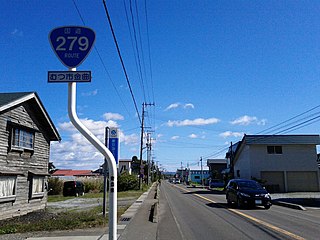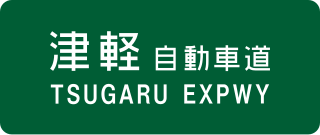
Aomori Prefecture ([a̠o̞mo̞ɾʲikẽ̞ɴ]) is a prefecture of Japan in the Tōhoku region. The prefecture's capital, largest city, and namesake is the city of Aomori. Aomori is the northernmost prefecture on Japan's main island, Honshu, and is bordered by the Pacific Ocean to the east, Iwate Prefecture to the southeast, Akita Prefecture to the southwest, the Sea of Japan to the west, and Hokkaido across the Tsugaru Strait to the north. Aomori Prefecture is the 8th-largest prefecture, with an area of 9,645.64 km2 (3,724.20 sq mi), and the 31st-most populous prefecture, with more than 1.18 million people. Approximately 45 percent of Aomori Prefecture's residents live in its two core cities, Aomori and Hachinohe, which lie on coastal plains. The majority of the prefecture is covered in forested mountain ranges, with population centers occupying valleys and plains. Aomori is the third-most populous prefecture in the Tōhoku region, after Miyagi Prefecture and Fukushima Prefecture. Mount Iwaki, an active stratovolcano, is the prefecture's highest point, at almost 1,624.7 m (5,330 ft).

Yokohama is a town located in Aomori Prefecture, Japan. As of 1 March 2023, the town had an estimated population of 4,258 in 2134 households, and a population density of 33 persons per km2, in 1,779 households. The total area of the town is 126.38 square kilometres (48.80 sq mi).

Noheji is a town located in Aomori Prefecture, Japan. As of 28 February 2023, the town had an estimated population of 12,249 in 6313 households, and a population density of 150 persons per km2. The total area of the town is 81.68 square kilometers (31.54 sq mi).

Kamikita District is a district located in Aomori Prefecture, Japan. It occupies the east-central portion of the prefecture, south of Shimokita Peninsula.
National Route 4 is a major national highway in eastern Honshū, Japan. Measuring 738.5 kilometers long (458.9 mi), it is the longest highway in the country. When oversea routes are included, it is the second longest highway in Japan, with National Route 58 then measuring 884.4 kilometers (549.5 mi) because of its maritime sections. The highway connects Tokyo and Aomori via Utsunomiya, Kōriyama, Sendai, and Morioka.

The Ōminato Line is a railway line operated by East Japan Railway Company. It connects Noheji Station and Ōminato Station on the Shimokita Peninsula in eastern Aomori Prefecture.

The Hachinohe Expressway is a 4-laned national expressway in the prefectures of Iwate and Aomori in the Tōhoku region of Japan. It is a spur of the Tōhoku Expressway, primarily serving the city of Hachinohe. Signed as E4A, it is owned and operated by East Nippon Expressway Company.
National Route 45 is a national highway of Japan connecting Aoba-ku, Sendai and Aomori, Aomori. Alongside Japan National Route 6, it is a main route along the Pacific coast of eastern Japan. It is paralleled closely by the incomplete Sanriku Expressway between Sendai and Hachinohe.

National Route 279 is a national highway of Japan that traverses the prefectures of Aomori and Hokkaido, as well as the Tsugaru Strait that separates them. The 134.0-kilometer (83.3 mi) highway begins at an intersection with National Route 5 in Hakodate, then crosses the Tsugaru Strait on a ferry from Hakodate to Ōma, Aomori, that it shares with National Route 279, where it then travels south through eastern Aomori Prefecture, passing through the city of Mutsu before ending at an intersection with National Route 4 in Noheji.

National Route 338 is a national highway in the Japanese prefectures of Hokkaido and Aomori. Route 338 stretches 241.3 kilometers (149.9 mi) from National Route 5 in Hakodate, Hokkaido south across the Tsugaru Strait by ferry to Ōma, Aomori, around the western, southern, and eastern edges of the Shimokita Peninsula and finally to Oirase.

National Route 394 is a national highway in the Japanese prefecture of Aomori. Route 394 stretches 185 km from National Routes 279 and 338 in Mutsu southwest to National Route 7 in Hirosaki.

The Michinoku Toll Road is a two-lane toll road in Aomori Prefecture connecting the cities Aomori and Hachinohe via Shichinohe. It serves as an alternative to Japan National Route 4, bypassing the towns Hiranai and Noheji by cutting directly through the Hakkōda Mountains and other mountains of the northern Ōu Mountain Range. The road is managed by the Aomori Prefecture Road Corporation and is numbered E4A as an extension of the Tōhoku Expressway.

The Aomori-higashi Interchange is the eastern terminus of the Aomori Expressway, a two-lane national expressway in Aomori, Aomori Prefecture, Japan. It is owned and operated by East Nippon Expressway Company. There is no toll gate at the interchange; drivers pay to use the end of the expressway at the Aomori Chuo Toll Gate.

The Kamikita Expressway is a free two-lane expressway in Aomori Prefecture connecting the towns of Shichinohe and Rokunohe. Alongside other tolled roads, the expressway is part of a series of highways that will link the Hachinohe Expressway to the Aomori Expressway. The road is managed by the Ministry of Land, Infrastructure and Transport and is numbered E4A as an extension of the Tōhoku Expressway. It is routed concurrently with an alternate route of Japan National Route 45.

The Aomori Interchange is the northern terminus of the Tōhoku Expressway as well as the western terminus of the Aomori Expressway, a two-lane national expressway in Aomori, Aomori Prefecture, Japan. It is owned and operated by East Nippon Expressway Company. The Aomori Interchange is the northern terminus of a continuous series of expressways that links Honshu and Kyushu, with a total 2,170 kilometers of expressway to Kagoshima Interchange in Kagoshima.

The Tsugaru Expressway is a two-lane national expressway in Aomori Prefecture, Japan. The expressway connects the prefecture's capital, Aomori, and the Tōhoku Expressway to the municipalities of Goshogawara, Tsugaru and, Ajigasawa. It is owned and operated by Ministry of Land, Infrastructure, Transport and Tourism and is signed as an auxiliary route of National Route 101 as well as E64 under their "2016 Proposal for Realization of Expressway Numbering."

The Sanriku Expressway is an incomplete expressway that exists in multiple segments in Miyagi Prefecture and Iwate Prefecture, Japan. The expressway connects Sendai, the capital and largest city in Miyagi Prefecture, to Miyako in Iwate Prefecture. It follows the coast of the Pacific Ocean in the northern parts of the Tōhoku region, otherwise known as the Sanriku Coast. It is owned and operated by East Nippon Expressway Company, the Miyagi Prefecture Road Corporation, and the Ministry of Land, Infrastructure, Transport and Tourism (MLIT). The route is signed as an auxiliary route of National Route 45 as well as E6 and E45 under MLIT's "2016 Proposal for Realization of Expressway Numbering." It is one of three routes numbered E45, the other two are the Sanriku-kita Jūkan Road and the Hachinohe-Kuji Expressway, and one of many routes numbered E6, although the Sanriku Expressway only carries the number close to its southern terminus in Sendai. When completed, all of these routes will form an expressway that travels from the Tokyo Gaikan Expressway in Saitama Prefecture along the Pacific Coast to Hachinohe in Aomori Prefecture.

The Hachinohe-Kuji Expressway is an incompleted expressway in the southeastern part of Aomori Prefecture and the coastal area of Iwate Prefecture in northern Japan. It is owned and operated primarily by the Ministry of Land, Infrastructure, Transport and Tourism (MLIT), but has a section maintained by the East Nippon Expressway Company. The route is signed as an auxiliary route of National Route 45 as well E45 under MLIT's "2016 Proposal for Realization of Expressway Numbering."

The Sanriku-kita Jūkan Road is an incompleted expressway in the coastal area of Iwate Prefecture in northern Japan. It is owned and operated primarily by the Ministry of Land, Infrastructure, Transport and Tourism (MLIT). It is routed concurrently with an alternate route of Japan National Route 45 and is numbered E45 under MLIT's "2016 Proposal for Realization of Expressway Numbering" as an expressway running parallel to the aforementioned National Route 45.

The Nanbu Jūkan Railway was a railbus line in eastern Aomori Prefecture, Japan. Services on the railway began 1962 and ceased in 1997 due to financial hardship. It connected Noheji Station in the town of Noheji to Shichinohe Station in the town of Shichinohe.



















